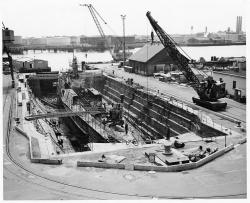
Society
Main Category
Sub Category
Era
Date Created
Location Country
us
Coordinates
36.820556, -76.293056
Address1
Rennshaw Street
City
Portsmouth
State
Country
Zip
Creator
Baldwin's dry dock in Virginia has been designated a National Historical Landmark and is still in use at the Norfolk Naval Shipyard. The Charlestown dry dock and original pump house, while no longer used, are on display as part of the Boston National Historical Park.
Although the need for dry-docking facilities to speed the cleaning and repair of ships in America's naval fleet was apparent as early as 1789, it was the War of 1812, and the burning of Washington, D.C., that finally convinced Congress of the importance of a coastal defense system based on a strong navy. It was not until 1827, however, that Secretary of the Navy Benjamin Southward finally commissioned Loammi Baldwin, Jr., to design and construct dry docks at the mouth of Chesapeake Bay and in Boston Harbor.
Built from a single set of plans and at a total cost of $1.6 million, the pair of docks were of a size and complexity previously unknown in the United States. Measuring 314 feet in length and 100 feet in width, the two projects together consumed seven years of effort and nearly a million cubic feet of New England granite. Adapting European techniques to available materials and technology, Loammi Baldwin, Jr., created an early monument to civil engineering in America that also strengthened the young country's naval capabilities.
Facts1. Modifying European construction in iron, Baldwin designed inner gates of wood shaped in a convex curvature as bracing against tidal forces, a concept also employed in the concrete arched dam.
2. With dry docks full of water, a ship was floated into place, then stabilized with supports. After the gates of the dry dock were closed, water was pumped out. Driving a set of eight lift pumps with a combined capacity of 18,000-cubic-feet per hour, steam engines could empty a dock in six hours.
3. The granite for both projects was mined and finished in Quincy, Massachusetts, hauled on the Granite Railway to the Neponset River, then transported by barge to Charlestown and by ship to Portsmouth, Virginia.
4. Baldwin supervised construction of the Boston dry dock in summer months and the Virginia dry docks in winter, otherwise leaving a principal assistant in charge; for his services, Baldwin was paid a salary of $4,000 a year.
5. Baldwin's dry dock in Virginia has been designated a National Historical Landmark and is still in use at the Norfolk Naval Shipyard. The Charlestown dry dock and original pump house, while no longer is use, are on display as part of the Boston National Historical Park.
Image Credit
Public Domain (National Park Service)
Image Caption
Gosport Naval Dry Docks


